“Donnie Darko” Explained — The Once and Future Teen
By
Owen Hammer
The 2001 film Donnie Darko, written and directed by Richard Kelly, is a movie made by a Gen Xer for Gen Xers. It takes place in 1988 when the title character, the director and most of the viewers were teenagers. There are plenty of films that incorporate the popular media and events of the ‘80s into its plot, but Donnie Darko is unique in its status as a film that speaks to a generation. It’s not about the fashion and music of those of us born during the Baby Bust, it’s about the larger issues—isolation, confusion and frustration. As if the world really is coming to an end.
Most cryptic films require people like me to start from scratch in my attempts to understand them. However, Richard Kelly has released a large volume of secondary text that supposedly contains the “official” explanation—“The Philosophy of Time Travel.” It’s not so much a solution to a puzzle as it is a cypher for turning a puzzle into a different puzzle. However, the book does give us a shared, canonical, “in-universe” language, so I will use it.
Donnie Darko is a movie about a boy who doesn’t have any choice. Free will is impossible when your fate is sealed. Even though the ending is supposed to be somewhat of a happy ending, Donnie is dead. Was it noble self-sacrifice if he was forced to do it? Is it a happy ending? Is Donnie a hero? Why do Gen Xers love a film that glamorizes a violent thug? These questions are all answerable. We just need to think about the film, understand why it makes us feel what we feel, and the answers will be staring us in the face.
Chapter 1 — What is the Timeline of events?
Rosseter of Twin Perfect said this about Twin Peaks:
ROSSETER: [Y]ou kind of have to explain everything before you can explain anything.1
The same is true for Donnie Darko. There’s just no obvious starting point in explaining it, so, let’s start at the beginning.
The movie begins on the morning of Saturday, 1 October 1988. Donnie is waking up from sleepwalking, well, sleep-biking to Carpathian Ridge—a remote cliff in his hometown of Middlesex, Virginia. On top of somnambulism, Donnie has many mental problems, and it’s revealed that he is under the care of a psychiatrist.
That night, the morning of Sunday, 2 October 1988 at 1:30AM, A jet engine crashes into the Darko house, killing Donnie instantly. The Darko family and friends cope with the loss.
Now let’s go way, way, way into the future. Several technological advances happen and someone or something is so powerful that it can see into the past and even change the past.
Kelly: Has someone broken the barrier in space and time for the very first time? For me, that’s sort of the idea that I’m trying to put out there . . . [S]omeone . . . in the distant future has . . . broken a barrier back to 1988 and they’re looking at 1988 right now, and they’re contacting this guy. . . Donnie . . . you’re seeing a super-power.2
We’ll call this entity “God” since that’s what he’s called by Donnie in the film and by Richard Kelly in interviews. Remember, this isn’t any specific god from any specific religion, this is the entity called “God” that is specific to this one film.
God decides to change the past so that Donnie Darko does not die on 2 October. The method God uses to save Donnie is to appear to him as FRANK—a spooky rabbit monster. Frank simply commands him to get out of the house. Donnie leaves after 1 AM, shortly before the jet engine hits the house.
Now we have a new timeline. If you saw Back to the Future Part II this is old hat. Everything from this point is new and different.
As the events of the film unfold, Donnie becomes convinced that “the world will end” in some way on the morning of 30 October 1988, a little more than 28 days in the future.
Most of the movie happens in this divergent timeline, and at the time specified as “the end of the world” an airplane carrying Donnie’s mother and younger sister is flying overhead. A wormhole opens up and sucks one of the engines into it and shunts it back in time. Now we know where the engine came from—it came from the future—specifically a future that now retroactively does not happen.
Here’s where a lot of people get confused. The event that causes the divergent universe is not the jet engine, it’s Donnie leaving the house. Donnie stays in his bed in one timeline and leaves the house in the other timeline. This main timeline—THE PRIMARY UNIVERSE—has been restored. The jet engine crashes into the house in both timelines. How is that possible?
Well, this is a minor point, but one that I will address since it seems to be the source of so much confusion. Any event common to both universes necessarily had to happen before the point of divergence. But the jet engine crashes after Donnie leaves the house. Are there two points of divergence? No. The engine needs time to fall through the sky. We know that because Elizabeth’s boyfriend honks the horn before the engine hits the house. If he can see it that far in advance, we can extrapolate how fast, or rather, how slowly it’s moving, and the numbers work out. The point is that Donnie’s presence is the only difference. The jet engine hits the house at 1:30AM no matter what.
Donnie is in a causality loop or simply a time paradox. He has to send the jet engine back in time because the jet engine was there. Why was the jet engine there? Because Donnie sent it. It’s circular logic. Like all stories with a causality loop, there is no inciting incident. This is a feature and not a bug. The relationship between cause and effect that defines stories (and reality) is missing. It’s weird. It provokes anxiety. It’s overdone, but I credit Donnie Darko for doing it well.
This idea was used in The Terminator (1984), 12 Monkeys (1995), The Star Trek Voyager episode “Time and Again,” Time Crimes (2007), Predestination (2014), Harry Potter and the Prisoner of Azkaban (2004), Tenet (2020) and of course Paradox (2016)—not a good film, but a masterclass in constructing a causality loop.
Let’s return to Frank’s initial contact with Donnie.
Frank: Twenty-eight days, six hours, forty-two minutes, twelve seconds. That is when the world will end.
What does it mean for the world to end? God wants Donnie to end the Tangent Universe, and Donnie does that. But the Tangent Universe was created by Frank’s intervention and Frank is an agent of God, so . . . did God change his mind? Yes. Richard Kelly explains in his commentary to the Director’s Cut:
Kelly: Whoever is behind the technology or whoever somehow ruptured the space-time continuum, they’re trying to fix this thing.3
This is critical to understanding the film. We are watching God sloppily clean up the mess he created. God is omnipotent and omniscient but not wise.
God, like the adults in Donnie Darko, seem all-powerful, but they’re a bunch of boobs with a lot power struggling to figure things out.
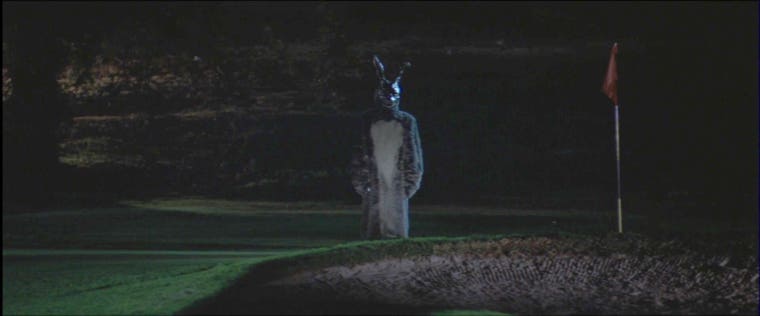
Note the literal red flag.
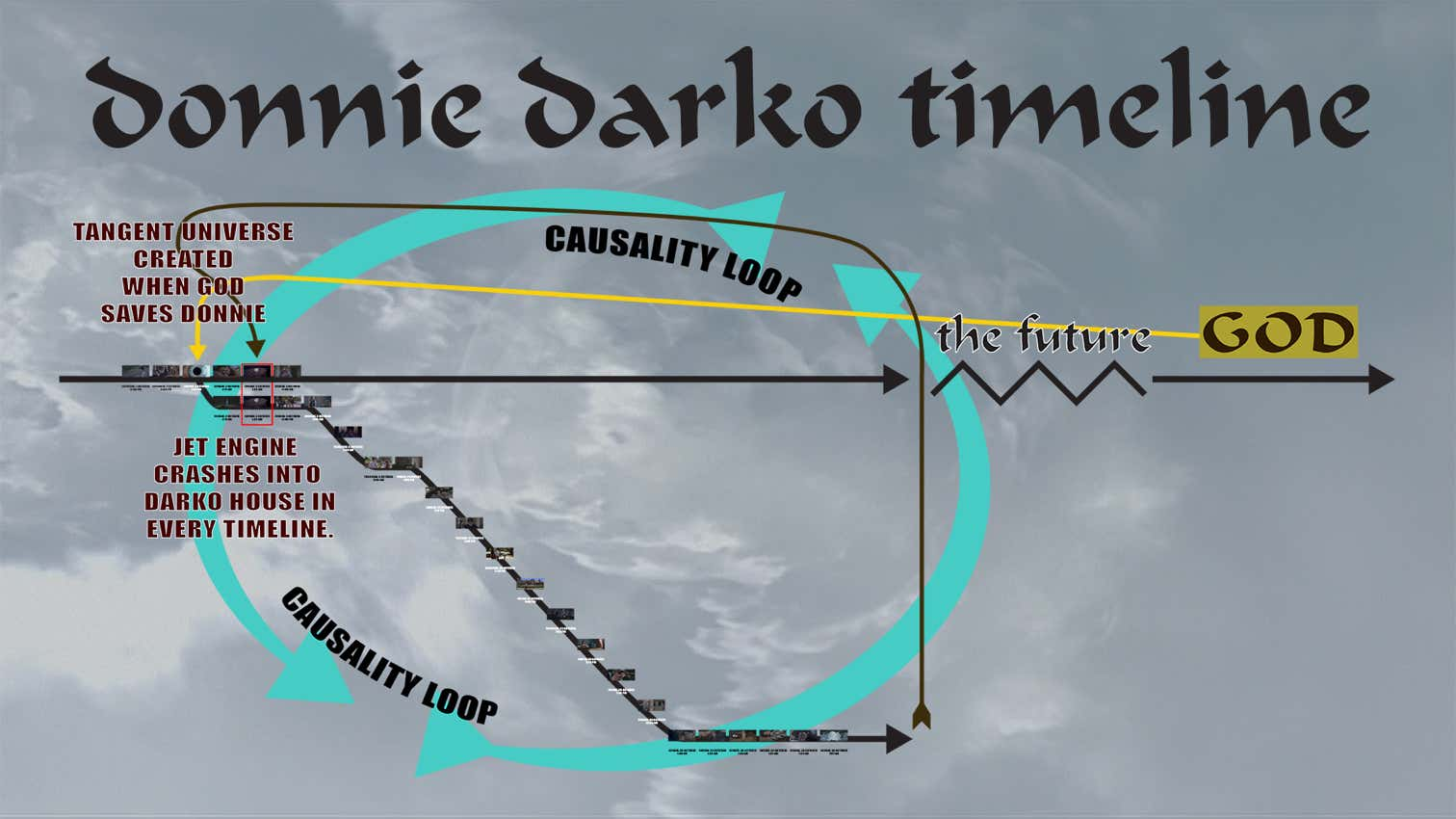
“God” creates a divergent timeline when he convinces Donnie to leave the house on the night of the crash. The crash, however, happens no matter what. After God changes history, he realizes he made a terrible mistake and tries to change it back. This is the story of Donnie Darko.
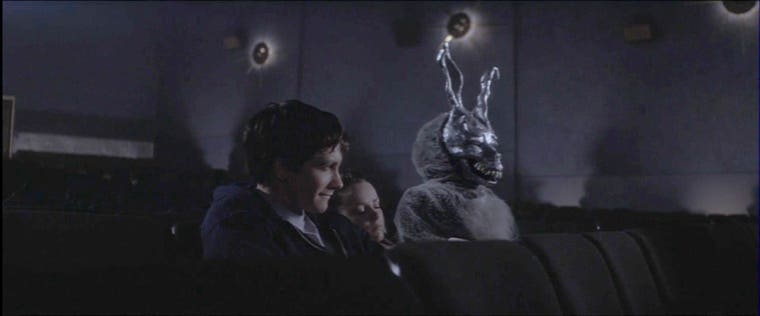
Frank tried to be subtle and it didn’t work. He resorts to showing up and ordering Donnie in no uncertain terms.
Chapter 2 — What is the ‘Tangent Universe’ and the ‘Manipulated Living?’
As soon as Donnie leaves the house, before the plane engine hits, the Tangent Universe begins, and, logically, as time passes, this timeline is increasingly different from the Primary Universe. But there’s more to it. God is constantly making adjustments to get the universe back on track. The story is a series of deus ex machina moments. God is flailing, frantically improvising a cosmic “undo.”
Let’s look at the twelve episodes of divine intervention. This is the best way to review the TANGENT UNIVERSE.
Number 1: Ms. Pomeroy’s inappropriate remark.
Ms. Pomeroy: Sit next to the boy you find cutest.
Ms. Pomeroy, and almost every character, is being controlled by God to get Donnie on track. It appears that the first priority is to get Donnie to fall in love with Gretchen. In fact, it’s possible that Gretchen’s placement at Donnie’s private school was orchestrated by “God.” It’s kind of a coincidence that she shows up on the first day of school after the divergence point.
The in-universe term for this is The Ensurance Trap. God forces Donnie to do his bidding, specifically by having him fall in love with Gretchen and then having Gretchen die so that Donnie will be happy to let the Tangent Universe cease to exist so that Gretchen will continue to live in the Primary Universe.
When characters do these things, they are THE MANIPULATED LIVING. It seems like an inefficient way to alter reality, but God is reputed to work in mysterious ways!
Number 2: Frank SPEaks to donnie.
The first time we see Donnie in health class, he watches the creepy Jim Cunningham video—creepy even before we know the truth of Jim Cunningham—and Frank speaks to him.
Frank (VO): Pay close attention, you could miss something.
It kind of sounds like Frank is talking to the audience. But no, Frank is calling attention to Jim Cunningham who will become Donnie’s adversary.
Number 3: Frank convinces Donnie to vandalize the school.
The second time Frank appears, he convinces Donnie to vandalize the school, damaging the mascot and flooding the classrooms. There’s a lot going on here, but because school is cancelled, Donnie walks Gretchen home. The movie is much more clear about the meaning of this scene.
Donnie: Well, I’m really glad the school was flooded today.
Gretchen: Why is that?
Donnie: Because you and I would never have had this conversation.
Gretchen: You’re weird.
Yeah, Gretchen, he’s weird, but he’s right. Donnie is figuring out the “rules” of the film he’s in. Vandalizing the school put Donnie and Gretchen together.
Number 4: Frank Appears to Donnie in the bathroom.
On Friday, 7 October 1988, Frank appears in the bathroom to Donnie.
Frank: Don't Worry. You got away with it.
Since Frank re-assures Donnie that he’s not putting himself at risk by following orders, we’ll assume that’s the reason he appears. Or, to put it another way, Donnie would chicken out, if not for this appearance by Frank.
There is a water-like invisible shield stopping Donnie from touching Frank. Frank cannot be touched. Whatever the mechanics are, holography, magic, whatever, it cannot account for physical contact between the two worlds. Frank is “there,” but he’s not ready to get close to Donnie. Frank, and by extension, God, is there to command Donnie, not to be understood by Donnie. The invisible barrier is a physical manifestation of the unknowability of God.
Number 5: Donnie sees the “workers.”
One of the most memorable visuals from Donnie Darko are the transparent tendrils that he can see. In universe, they are called “workers,” and they evoke liquid, even though they are not made of any liquid.
The tendrils indicate what a person will do. They are communicating information from the future, and therefore fit into the causality loop structure wherein all things are predestined. However, now Donnie can see everyone’s destiny, including his own.
Why did God spring this ability on Donnie? Well, Donnie follows his “worker” to the gun that his parents keep hidden. Donnie will need that gun later, so, I conclude that this is the primary reason for this intervention. Without the gun, Donnie does not shoot Frank. We’ll talk about why God would want this macabre outcome later, but for now, understand that God is leading Donnie to the gun.
Number 6: Frank Appears to Donnie in the bathroom (part 2).
Donnie is frustrated that he cannot make contact with Frank, so he plots to break the “barrier” between him and the space occupied by Frank. He’s not trying to stab Frank. He just wants to get close to Frank. Donnie is exercising some initiative. He wants to understand who this specter is before he obeys any more commands.
Even though the stabbing does not break the force-field, Frank seems despondent, as if the stabbing hurt him. The stabbing aligns with Frank’s eye, and Donnie will eventually shoot Frank in the eye, killing him, so this could be foreshadowing. But why would Frank be upset at Donnie’s impotent action?
Donnie doesn’t trust Frank. Attempting to get close and understand him means that Donnie is still being analytical and not obedient. The plan is failing.
Number 7: “Send Her a Letter”
Frank can be heard but not seen again. He commands Donnie to send a letter to Roberta Sparrow, a.k.a. “Grandma Death.” There’s a lot of meaning to this, what’s in the letter and what Donnie is responding to. However, the important thing is that Grandma Death has to be physically positioned at the mailbox at an exact time so that Frank will swerve to miss her and hit Gretchen.
Without Gretchen’s death, Donnie has no motivation to save the Primary Universe. So, really, what we are witnessing is God putting all the pieces in place for an intricate plan. Can God just put all the pieces in place with one simple action? Apparently not. This seems like sloppy work, but this is not the infallible God of religions. The God of the Donnie Darko universe does things in a convoluted and half-baked manner—a clue to his real identity.
Number 8: “Now you know where he lives”
Prior to Donnie burning down Jim Cunningham’s house, he finds Cunningham’s wallet in front of his house.
Frank: Now you know where he lives.
Did God put the wallet there, or was it an incredibly lucky coincidence that Cunningham dropped his wallet on the same day that his enemy was walking down the street? Honestly, the movie is so bonkers now, that it is foolhardy to even ask the question. We are not watching a work of naturalism, where the “rules” of the real world are in effect to some extent. Not only is God controlling reality, but he is being incredibly obvious about it. If we think of Cunningham’s sprinkler system as a “shield” against fire, then God is making it very clear that the house is ready to be burned down when the sprinklers suddenly stop.
Why did God do this? Well, if the house wasn’t burned down, the Fire Department wouldn’t have discovered Cunningham’s crimes, he wouldn’t have been arrested, Mrs. Farmer would have taken Sparkle Motion to L.A. and Donnie’s mother wouldn’t have been on the plane from Los Angeles. God’s plan isn't efficient, or moral, just logical.
Number 9: Frank confronts Donnie at the movie theatre.
Frank is comfortable getting close to Donnie now. Presumably, Donnie won’t attack the force-field with a knife. Frank removes his mask to reveal that he is a regular human—a dead human—but not a demon. The two have become close as Donnie is getting increasingly comfortable obeying God.
When God prompted Donnie to burn down Cunningham’s house, he didn’t understand. So, Frank appears in person to speak in no uncertain terms.
Frank: Burn it to the ground.
God is getting more demanding, and demanding increasingly violent and transgressive acts. Also, he is getting much less subtle.
Number 10: Ms. Pomeroy incepts “Cellar Door.”
The film has no problem with the episodes of “Divine Intervention” being as clunky and conspicuous as possible, now. Ms. Pomeroy, leaving the school for the last time, tells Donnie that “a famous linguist” once said that the most beautiful phrase in the English language is “Cellar Door” and even writes the word in beautiful cursive on the blackboard. The only way this could be more conspicuous is if there was a literal red flag in the scene, and there almost is—Ms. Pomeroy is carrying a full-sized American flag with her belongings. She brought her own full-sized American flag to her job at a school?
This scene is all about Ms. Pomeroy—A Manipulated Living. She is pushing Donnie to enter the cellar door at Roberta Sparrow’s house.
Donnie enters the cellar and is attacked by school bullies Ricky and Seth. They are there to steal from Roberta Sparrow. In an earlier scene there’s another clunky bit of exposition when Donnie’s father mentions “gems” that “kids . . . tr[y] to steal.”
Ricky and Seth are plotting to steal the gems, which may or may not exist. The important thing is that the pieces are in place. Grandma Death goes to the mailbox to get the letter Donnie left, and this causes Frank to swerve to miss her. Again, the plan is logical, not efficient or moral.
Number 11: Frank appears at the therapist’s office.
Frank tends to appear at times of altered consciousness, so it’s not a surprise that he appears at Dr. Thurman’s office while Donnie is being hypnotized.
Donnie is telling Dr. Thurman that Frank intends to kill someone, which is kind of true. Was Donnie about to give away the ending to the movie? Was he about tell Dr. Thurman that Gretchen is the one who is going to be killed by Frank? If he has, Dr. Thurman might have intervened, and ruined the Ensurance Trap, so, Frank has motive to appear at this exact second.
Dr. Thurman does contact the Darkos about Donnie’s confession, but she might have done so more effectively had she known about a pending homicide, so, this explains why God needed to intervene.
But let’s think again about who God is and what the nature of the Donnie Darko universe is. Donnie explains enough of god’s plan to paint the picture of a completely chaotic universe ruled by a capricious, unreliable entity and Dr. Thurman rejects this.
Dr. Thurman: If the sky were to suddenly open up . . . there would be no law . . . there
would be no rule.
Dr. Thurman is right, if we think of her as talking about physics, but she is wrong if we think of her as talking about society. Donnie Darko is a movie about a world created by adults that is royally fucked up, populated by kids who are reliably fucked up. Dr. Thurman seems to be confusing nature and society, which is exactly what all the adults of the Donnie Darko world do. They think that the arbitrary rules they have created are as natural and logical as the laws of physics. This is why such a delusion is called a “God Complex.” Now we can start to understand not just the logic but the meaning of the film.
Number 12: Donnie sees the “workers” (Part 2)
It appears that God has come close, very close, to putting all the pieces on the board, but then Donnie gets one more push. This “worker” takes him to the whiteboard reading “Frank was here went to get BEER.”
The handwriting on the whiteboard is the same as the timecode written on Donnie’s arm and the graffitied “They made me do it” on the school grounds. Frank, this new character, would appear to be the same person who has been controlling Donnie, who is also named Frank. Are there two “Franks?” Kind of.
What we don’t know until now is that there is a real human named “Frank” in the story—Donnie’s sister’s boyfriend—Frank the artist. Also, Donnie decides to investigate the “worker” more carefully, putting his face right into the tendril and discovering its nature. First of all, it’s not liquid, it’s empty space. Secondly, it’s a tunnel through time, exactly what Dr. Monnitoff had described.
Donnie is prompted to go to Grandma Death’s house. He must understand, on some level, that Frank is going to be involved in a murder at Grandma Death’s house very soon, and he needs to be there.
So those are twelve instances of divine intervention. Note that what is called The Tangent Universe is not a single divergent timeline, but multiple divergences, forming a curve that is literally tangent to the Primary Universe, if we imagine the latter as a straight line.
Kelly: The way I look at it is like a tree, that the Primary Universe is the trunk of the tree and the Tangent Universe is like a branch [. . .] the idea is that the branch eventually deviates so far away from the trunk that eventually it’s going to peter out, end, and then snap off.4
Note that the image adorning the first chapter of the print version of “The Philosophy of Time Travel” is a tree.
Now that we’ve laid down this groundwork, let’s ask ourselves a very important question.
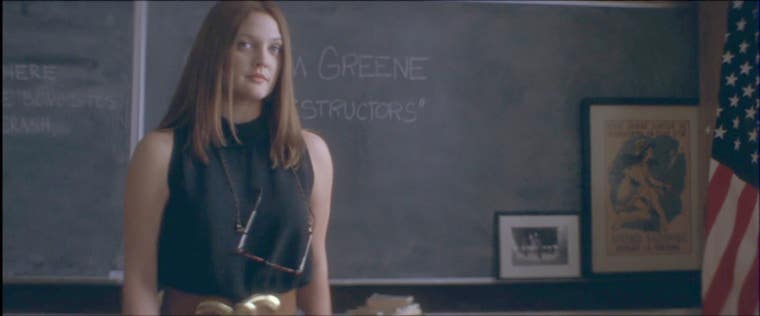
So much bizarre behavior in Donnie Darko can be understood as the characters specifically working to make God’s plan happen absent any other story logic.
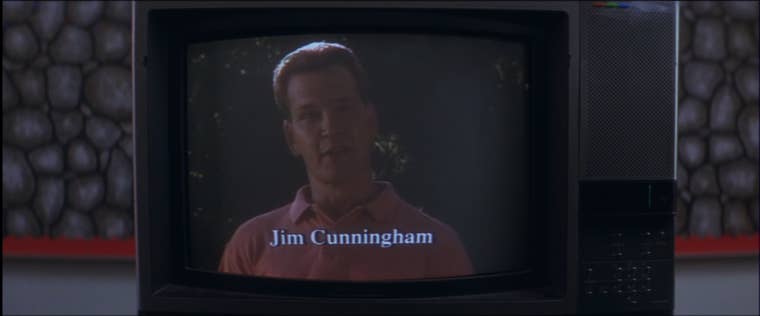
Donnie—and by extension, the audience—better remember this name and face.
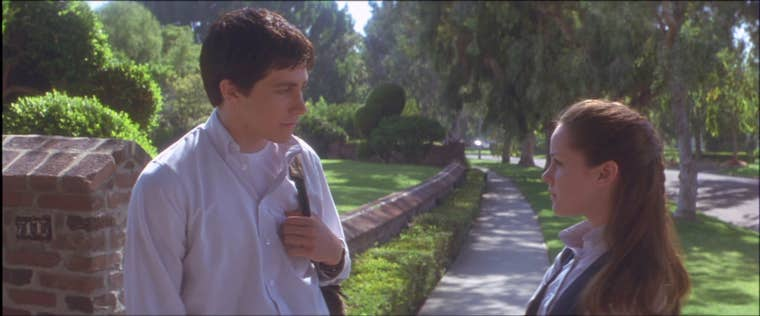
A meet-not-so-cute, when you think about it.
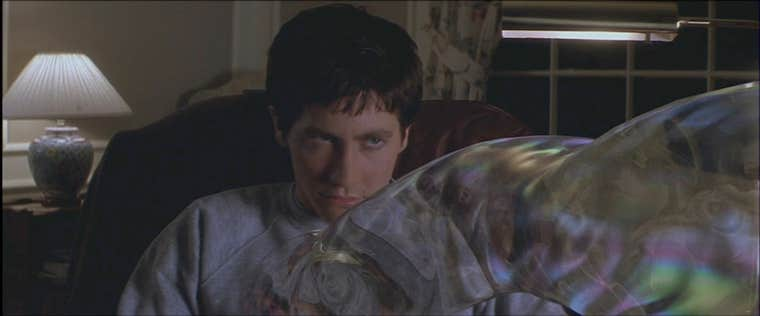
How do you visually describe someone seeing into the future? Richard Kelly has an ingenious solution.
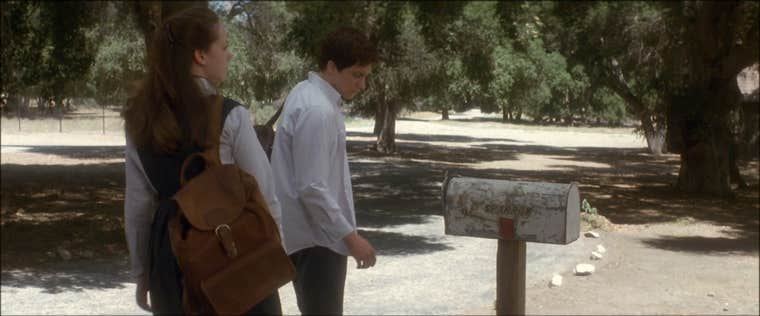
Frank commands Donnie to write a letter to Roberta “Grandma Death” Sparrow, but communicating with his elder is not part of the plan. God is putting the pieces on the board.
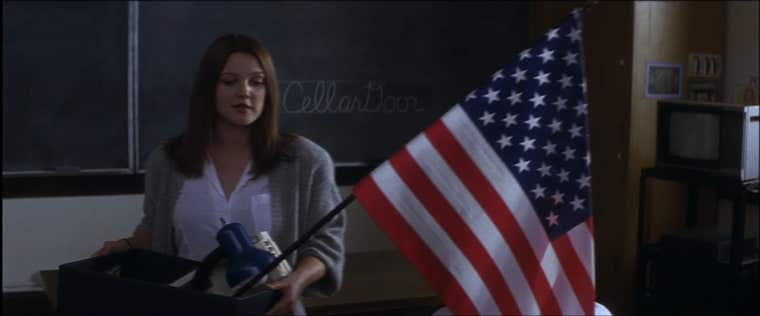
This might be important later. Hint, hint. Wink. Implausibly Patriotic English Teacher OUT!
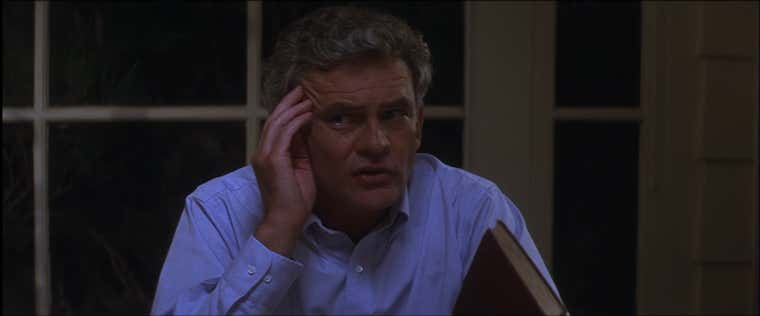
This might be important later. Hint, hint. Wink. We got any Anacin?
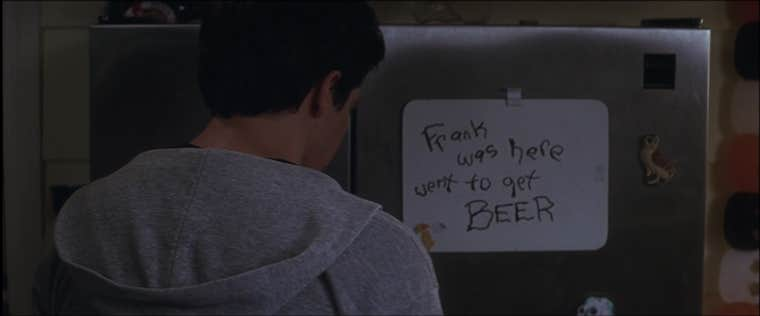
Note that the handwriting is the same as the timecode on Donnie’s arm and “They Made Me Do It.”
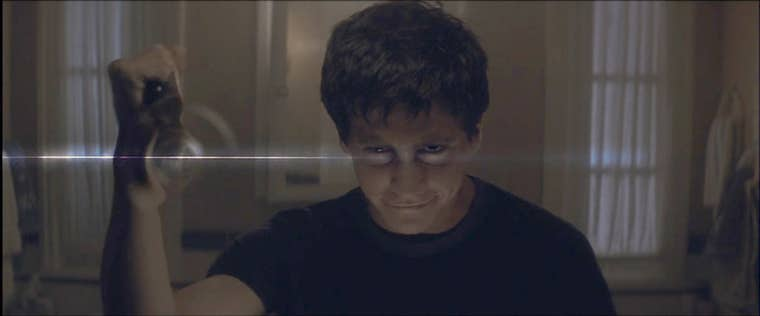
Donnie isn’t trying to stab Frank. He’s trying to break the barrier.
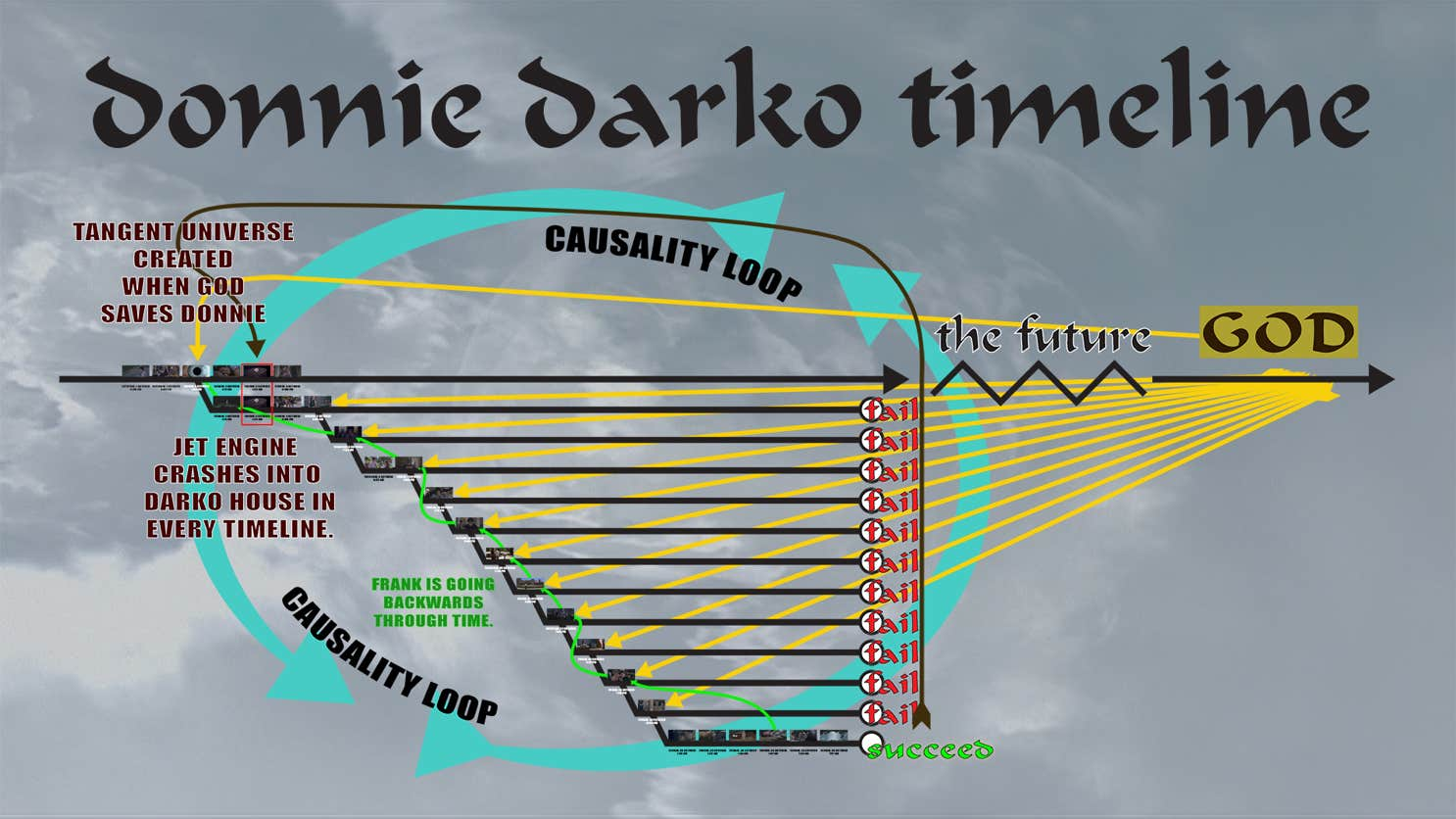
And you thought this was going to be complicated.
Chapter 3 - What Is ‘Real’ in Donnie Darko?
What is literal and what is metaphorical? Usually, a movie with so many things that don’t make sense is meant to be symbolic . . . or it’s just badly written, but I like to think that I weed those films out.
We cannot take the film literally, at least not entirely. When trying to explain a cryptic film, I always advise to look at the small things along with the big things. Forget about demon rabbits and time travel; there are a lot of small, subtle things that don’t make sense.
The film’s location, Middlesex, Virginia is an impossibility. The unpaved side street—Old Gun Road—where Roberta Sparrow lives, is the most important street in town. Everybody has to take this road to get anywhere. Traveling from school to Dr. Thurman’s house—Old Gun Road. Traveling from School to the Farmer house—Old Gun Road. Traveling from the liquor store to the Darko house—Old Gun Road. The characters are drawn to this location in an unnatural way.
Richard Kelly has often claimed that Donnie Darko is supposed to be a superhero. He has an alliterative name, he fights for a cause outside the law, and he has superpowers. However, he also has an attribute of superheroes rarely discussed—unrealistic access to resources. He has an axe when he goes to vandalize the school. This is an industrial axe, not the kind that a suburban home would have. Did the school have it? Does Leroy moonlight as a lumberjack?
Where does he get the gasoline for the fire? When he walks to the house, he’s empty handed. Cunningham kept a large can of gasoline in his house in case a neighborhood kid wanted to get revenge?
Where did Donnie get the gun? From his parents’ bedroom? Well, okay, but did he have it on his person from the minute he left his house? If so, why didn’t he pull it on Seth when Seth was trying to murder him. The simple answer is that he didn’t want to or didn’t need to pull a gun on Seth, so he didn’t have a gun. Not so for poor Frank.
Batman (1966) made fun of this trope when Batman is attacked by a shark and he not only has shark repellent, but he has Batman branded shark repellent. This is a conscious choice by the filmmakers to reference superhero tropes.
There’s more. Look at the whiteboard on the refrigerator in the Darkos’ house. Donnie takes the marker, and it’s never replaced, but people keep writing things on it. It’s not impossible that they all have their own markers, but, for our purposes, isn’t it more useful to think that the things written on the whiteboard are written for our benefit? There were script supervisors, continuity, and a props department. If this was a continuity error, someone would have fixed it. The filmmakers wanted it this way. The important thing is that we cannot understand Donnie Darko as a literal, naturalistic work.
So where does that leave us? Well, let’s talk about Donnie himself.
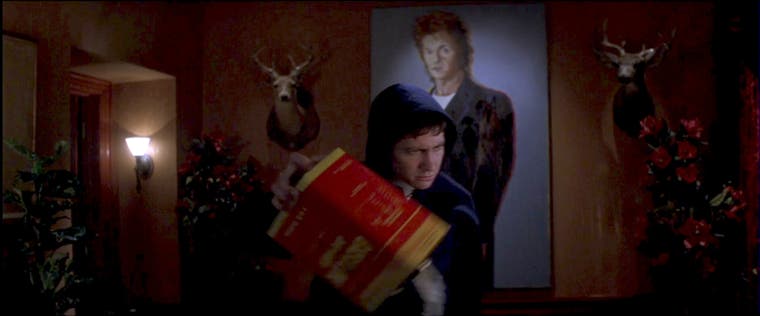
A very considerate pedophile.
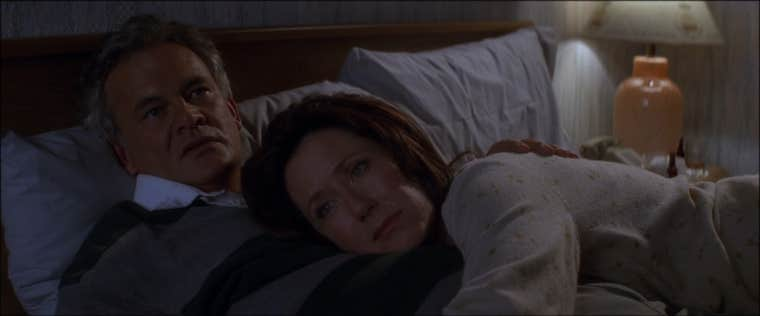
Eddie Darko’s seemingly random recollection is a clue that the “Living Receiver” phenomenon is a common occurrence.
Chapter 4 - What is the Living Receiver?
Remember, I’m using Richard Kelly’s in-universe terminology. He calls Donnie The Living Receiver. This is the name for a person who is being instructed by intelligence from the future to change history. It’s easy to tell if someone is a Living Receiver, because they ultimately die a mysterious death.
Who are the other Living Receivers? Let’s start with Frankie Feedler, an off-screen character who is briefly mentioned by Eddie Darko.
Eddie: Frankie Feedler . . . You remember him from high school? He died, remember? On the way to the prom. He was doomed. They could have said the same thing about Donnie. Our Donnie. But he dodged it. He dodged his bullet, Rose.
He dodged “his bullet,” not “a bullet.” He was doomed, and people are probably saying the same thing about Donnie, in the Primary Universe.
So, did Frankie Feedler—note the alliterative name — also die to save the universe? I think so. No one remembers him as a martyr because those events are wiped out of the timeline. In the end of the film, several characters “remember” Donnie Darko. I think that Eddie’s strong feelings about Frankie Feedler indicate that, a generation earlier, he was one of the people who had a haunting dream about a person who, by all accounts, died in an accident. You don’t feel that someone was retroactively “doomed” after an apparent accident unless there’s more to the story.
There are several references to a Mayan being killed by an arrow that seemingly came out of nowhere and a soldier in Medieval Europe being killed by a sword that also has a mysterious origin. Both are metal, like the jet engine. Here’s a quote from Chapter 12 of “The Philosophy of Time Travel.”
Metal is the transitional element for the construction of Artifact Vessels. . .
Ancient myth tells us of the Mayan Warrior killed by an arrowhead that had fallen from a cliff, where there was no Army, no enemy to be found. We are told of the Medieval Knight mysteriously impaled by the sword he had not yet built.
A metal object, called The Artifact has to kill the Living Receiver and we later learned that the Artifact cannot be traced to its origin because it comes from the future. This is how the knight was killed by a weapon that did not yet exist. Here’s a quote from Chapter 4 of “The Philosophy of Time Travel” whose symbol is an axe:
Divine intervention is deemed the only logical conclusion for the appearance of the Artifact.
The jet engine was Donnie’s metal “Artifact,” delivered by divine intervention.
So what happens if the Living Receiver fails? The universe is destroyed, right? Well, the Primary Universe is destroyed. The rules don’t say that the Tangent Universe is destroyed. If the Living Receiver failed, we know a few things: they’ll be alive, their life will be miserable, and they’ll know a lot about Time Travel. This describes Roberta Sparrow.
If Sparrow failed in her duties as the Living Receiver, that means that the Primary Universe of Donnie Darko is the Tangent Universe from her perspective. A Living Receiver has a lot of dead people on their hands at the end of the Tangent Universe. Donnie is directly or indirectly responsible for the deaths of dozens of people. If he failed in his mission, he’d have a miserable life, becoming known as the weirdo who was involved in the death of a lot of people. An old woman with such a reputation might be called “Grandma Death.”
It’s clear that Grandma Death wants to help Donnie succeed in his mission, but maybe she wants him to succeed where she failed. “Everyone dies alone” is a weird thing to say to a person, unless you’re trying to convince them that dying alone in your bedroom one night is better than living through what she lived through.
Remember Old Gun Road? Grandma Death lives on a back road that has more traffic than any other road in town. The characters are drawn to her because the world revolves around her to a certain extent.
So, that’s the meaning of being a “Living Receiver.” What about the other characters? Well, Kelly has a name for them too.
Chapter 5 - What are ‘the Manipulated Dead?
I covered the fact that the other characters in the movie are being manipulated by God, but “The Philosophy of Time Travel” differentiates between The Manipulated Living and The Manipulated Dead, and the rules seem inconsistent at first glance.
Frank is supposed to be a “special” manipulated person since he dies in the Tangent Universe and returns as a “reverse ghost”—a specter appearing before death instead of afterwards. Gretchen is also a Manipulated Dead and she doesn’t act any differently than the other characters. I’ll explain this discrepancy later. Let’s stay focused on Frank.
While logically, Donnie should know Frank, the two never meet in the Tangent Universe. The only time they cross paths, prior to the ending, is when Donnie bikes home and Frank drives by. That’s him in his Red Trans-Am. Perhaps he spent the night at the Darko house and was sneaking out.
It’s very obscured, but Frank is Elizabeth’s boyfriend.
Elizabeth: (into the phone) No. I took a year off to be with you.
That’s Frank she's talking to. She must be committed to him to delay college for a year.
When an off-screen character honks the horn before the jet engine crashes into the house, that’s Frank. When Frank leaves the Halloween party to get beer, that’s not supposed to be cryptic. It’s “alive” Frank going to get beer for the party. Donnie is disturbed by the message, as if he is remembering something. Is he remembering that Frank, the ghost, is Frank, his sister’s boyfriend? That would be very strange. Why would he forget his sister’s boyfriend? A better question would be: why does the film bend over backwards to keep “alive” Frank out of the story?
It’s because the story itself is a manipulation. We, the audience, are being kept in the dark. Does Donnie know that Frank, the ghost, is an incarnation of his older sister’s boyfriend? It doesn’t seem like it. When Dead Frank removes his mask, Donnie doesn’t react like he knows who it is. Donnie “remembers” who Frank is exactly when we learn who Frank is. When Donnie carves a pumpkin to look like the demonic rabbit head, Elizabeth doesn’t say, “hey that looks just like the Halloween mask my boyfriend is making.” At the Halloween party, Elizabeth asks a friend something she may as well be asking the audience.
Elizabeth: Have you guys seen Frank?
The movie itself seems to be answering the question when Donnie sees the whiteboard. “Frank was here went to get BEER.” This is an epiphany for Donnie. Is he remembering that Frank is Frank, or is he knowing it for the first time? We, the audience, are knowing it for the first time, but Donnie should already know this. What’s going on?
To answer these questions, we just have to do one simple thing and explain the nature of God.
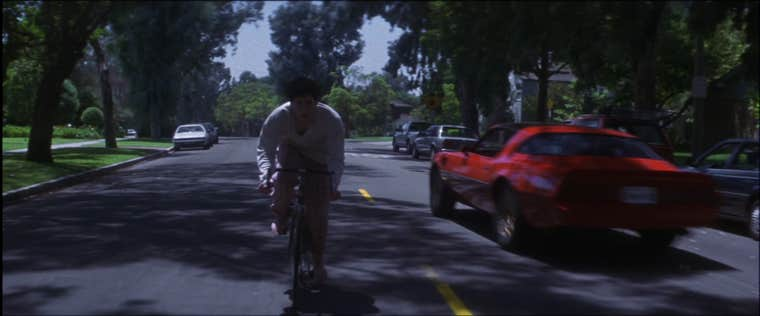
Yes, that’s Frank.
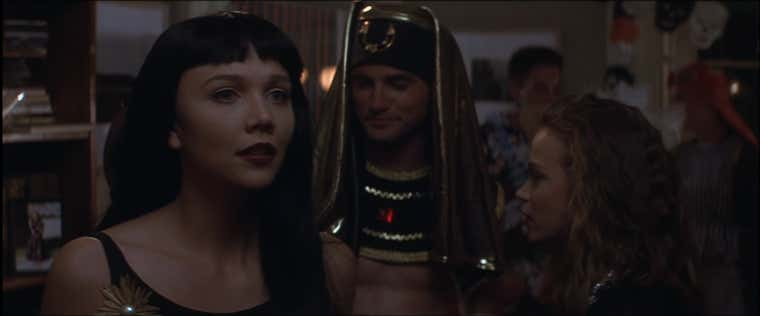
Has anyone seen my suspiciously off-screen boyfriend?
Chapter 6 - Who is God?
God is pushing Donnie to do things, and at a certain point the will of God and the will of Donnie are indistinguishable. This implies that God isn’t merely intervening, but God has created and is controlling everything, which is “on brand,” I guess.
This means that the diegesis of Donnie Darko is indistinguishable from the imagination of God and therefore the “God” character is the real-life creator of the story.
Richard Kelly is God. The movie documents Kelly creating a “universe” so complex that it has branching timelines—contingencies in case Kelly revises the narrative. The movie is Kelly recalling his life.
However, Donnie Darko is not a stand-in for Kelly. So who is Donnie? Donnie Darko is the dark teenager that Richard Kelly did not become. Kelly is recalling his decision to conform, and to not transgress. When the jet engine kills Donnie, that’s Kelly, in his youth, deciding to not be a “dark” kid.
When Frank, prompted by “God” in the future, stops Donnie’s demise, that’s Kelly wondering what life would be like if he had made a different choice. What if he had told off the authoritarian gym teacher? What if he had told off the hypocritical speaker? What if he had made a move on that cute girl? What if he broke and burned down the institutions that he despised? This ultimately leads to consequences so terrible, that, metaphorically, the world has ended.
Early in the film, Donnie predicts his future and fantasizes about the present:
Donnie: I think when I grow up, I want to be a painter. Or maybe a writer or maybe both. Then I'll write a book and draw the illustrations like a comic book. You know, change things.
Gretchen: Donnie Darko is a cool name. Sounds like a superhero.
Donnie: What makes you think I'm not?
Richard Kelly can grow up to be an artist—a goal that can be achieved in the real world—the Primary Universe. Being a superhero is not a goal that can be achieved in reality, so it happens in a fantasy—the Tangent Universe.
Now, keep in mind that God doesn’t have to be specifically Richard Kelly, but Generation X in general who is the confabulator. I have to pause the explanation and talk about representation. Kelly represents some members of Generation X, but at least Kelly has some self-awareness about his privilege. This is him from the director’s commentary which he did with director Kevin Smith, who, I guess, just gets to be on director commentaries:
Richard Kelly: I’m a white, upper-middle class American male teenager growing up, and I guess my story is . . . a lot easier to get made than if I were, you know, a bisexual Eskimo who was hearing impaired . . . I had the benefit of maybe telling a story about the all-American suburbs that is easier to push through the system.
Kevin Smith: I would really like to see the time traveling bisexual Eskimo picture.5
Inelegantly stated (Eskimo is not the proper term for Inuits, Aleuts and Yapiks) but true nonetheless. We need to get more marginalized people into niche cinema.
Okay, back to the explanation. Kelly, in roughly 1999, regrets his decision to be a meek conformist and rethinks his decision. He mentally goes back to when he was young and recounts the hypothetical future imagined by his younger self. This is the Tangent Universe.
But, of course, the story doesn’t end there. Twenty-four-year-old Kelly regrets the decision. So, he has Donnie Darko survive the accident so he can retroactively be that person in the past. However, Kelly then regrets that decision, and now he has to get this story to be identical to the story he created when he was young, or there is no good reason for him to have not become Donnie Darko.
This is why things happen in forward and backwards time and why Donnie’s agency diminishes over time. 11-year-old Kelly is creating this story from the past moving forward, and he can alter the story based on his whim, so Donnie has agency. 24-year-old Kelly is remembering the story and getting it to conform to the established story, forcing Donnie to do things he has to do because he already did it. The bizarre inconsistencies of Donnie Darko are all about cognitive dissonance.
[A] Tangent Universe . . . will collapse upon itself, forming a black hole within the Primary Universe capable of destroying all existence.
If we think of the Primary Universe as reality, and the Tangent Universe as a wholly imagined alternative version, then we can understand what “the black hole” is. If Kelly is getting so wrapped up in his imagination, he will eventually become delusional. The Primary Universe is the real world as remembered by Kelly, so if the Tangent Universe is what he “remembers,” then he has lost touch with reality. This is the Primary Universe falling into a black hole.
At the end of the film when Donnie and God are one, this figment of Kelly’s imagination is doing what Kelly insists he do, as would happen in an ordered mind. Kelly has returned to sanity meaning that he remembers reality meaning that the Primary Universe is saved.
Kelly: I think I was probably going mentally insane when I wrote this . . . 6
He may have been exaggerating, but the seemingly arbitrary time limit that Frank gives—twenty-eight days—that’s how long it took Kelly to write the screenplay and Kelly has acknowledged that he used that length of time for that reason. 7 8
If Donnie is not Richard Kelly, is there a character who does represent Kelly? Yes. It’s David—The little kid at the end of the movie who talks to Gretchen.
Kelly: People ask who I am in this movie . . . I wasn’t Donnie Darko. I was this kid. This was me.9
David is the young version of Richard Kelly who first imagines becoming Donnie Darko. This kid is not dark, literally and figuratively. He’s sweet, guileless and pale with blonde hair.
The two sides of the street represent two paths for Kelly. He can be Donnie or he can be David. You might be thinking, “now, wait a minute, Hammer. This kid has three lines! A director self-insert wouldn’t be such a minor character.” Well, the film is called Donnie Darko not David Lighto. The movie isn’t about David just as it’s not autobiographical. The movie is an exciting story about the monster Kelly did not become. Would you pay to see a movie about the nice kid that Kelly did become? The very last shot is David showing empathy—a kind of impotent empathy—a sign that he is conformist, not transgressive. This is the final shot of the film.
And why did Kelly choose to not be Donnie Darko? Because of morality? Because of principles? Because he loves his family? Well, yeah, but let’s be realistic. Just before the Tangent Universe is annihilated, the cops show up. We don’t know if they figured out that Donnie vandalized the school, burned down Cunningham’s house, killed Frank, or some combination, but this is the reason why more people are orderly. Society has a monopoly on violence to control rebellion. Richard Kelly didn’t want to be punished.
But is that it? Are there only two choices, just like Mrs. Farmer claims? Kelly can be a meek conformist or a violent psychopath? Kind of, yeah. The something in between, someone who rebels in a constructive way, who works within the system, this is essentially impossible. Generation X was not raised with these skills. We couldn’t find a third way if we wanted to. Parents, school and society conditioned us to think that we could be good or bad.
Donnie: You're just lumping everything into these two categories . . . and, like, denying everything else.
Yup, she sure is. This happens to Donnie, and it happened to Richard Kelly.
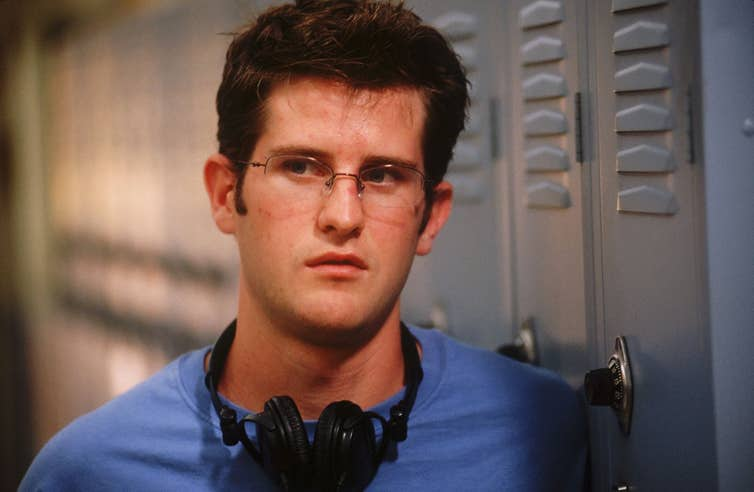
Director Richard Kelly. Photo Credit: Arrow Films
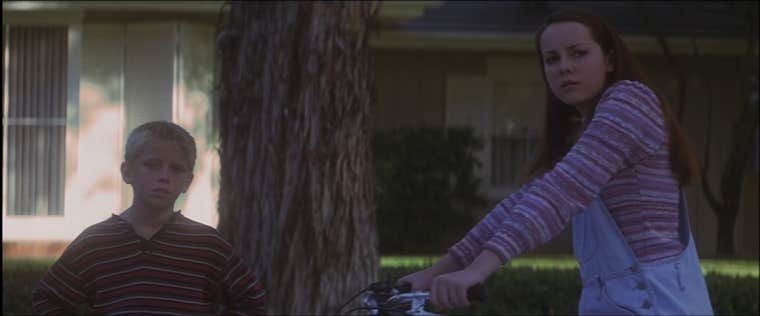
David is the child that Richard Kelly was while Donnie is the teenager he did not become. Note that David does not appear in the film until after Donnie is dead.
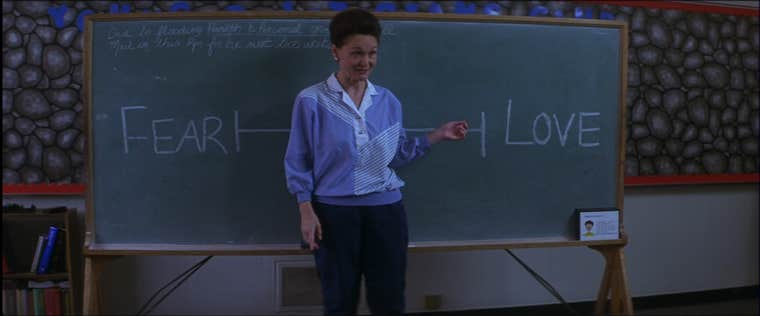
One of the most important recurring themes of Donnie Darko is the phenomenon of adults trying to control kids by creating a false dichotomy. The ultimate manifestation of the false dichotomy is Kelly’s belief that he can be meek David or violent Donnie, but not anything in between.
Chapter 7 - Who is Frank?
Having established that Frank is Elizabeth’s boyfriend, that he’s a “reverse ghost” and that he’s an artist, there is still so much to explain. Why the rabbit mask? A reference to “Alice in Wonderland?” A reference to “Watership Down?” Or is it just a creepy-looking mask?
I’d bet money that it’s just a creepy-looking mask. The face has just enough signifiers of “rabbit-ness” that our brain sort of goes to the index card “rabbit.” However, it’s so unlike a rabbit that our brain kind of breaks. Kubrick did the same thing in The Shining with a bear-like mask. It’s one of the most disturbing images in cinema. Replace “bear” with “rabbit” and you have Frank.
Frank is linked to Donnie in a very important way. Donnie considers becoming an artist and Frank is becoming an artist. We don’t know if he’s in art school or if he’s teaching himself, but look at all of his drawings and compare them to the drawings made by Donnie. They look similar, as if they were made by the same person. Out-of-Universe, they were made by the exact same person: Richard Kelly. Just like Donnie is a dark sixteen-year-old that Kelly did not become, Frank is the artsy twenty-one-year-old that Kelly did become.
This tracks with the theme of certain characters representing Richard Kelly at different ages in the real world, and how he imagined himself at different ages. If David is Kelly before he did not become Donnie Darko, then Frank is Kelly after he did not become Donnie Darko.
Donnie says that he stopped vandalizing houses in the sixth grade, when he would be eleven, and that, because of his criminal record, he cannot drive until he is twenty-one. This means that there is continuity between David and Frank, who is often driving his Trans-Am at age twenty-one.
Now we can understand why Frank seems to be on the fringes of the story. We’re in the Tangent Universe where Kelly is replaced by Donnie Darko.
Rose Darko: [I]t would be nice to look at you some time . . . and see my son. I don't recognize this person today.
Donnie Darko doesn’t go on to be an artist. He might not even be alive at age twenty-one. So, Frank can’t be in the story.
When Donnie enters the story, Frank drives off in his Trans-Am. After Donnie is dead, we can see Frank again. When Frank attempts to enter the story while Donnie is still in it, well, all the worse for Frank.
Much of the movie is “God” putting the pieces on the board—putting Gretchen and Grandma Death and Rose Darko in the exact right position, so a character who does not belong on the board has to be removed. This is why Donnie murders Frank. It’s not an act of malice, it’s an act of logic. Frank cannot be there. Once Frank is dead, the image of Frank, with and without the mask, is kind of “up for grabs.” God can use it as the image he will project into the past. Kelly at age 24 is telling Kelly at age 16 to become this thing that was Kelly at age 21.
So, now we understand what a Manipulated Dead is. But how is Gretchen also a Manipulated Dead? If Frank is cleared from the board because he doesn’t belong there, then what about Gretchen? Sixteen-year-old Kelly may have had his first girlfriend, but does the transgressive Donnie Darko get a girlfriend? Maybe, but he doesn’t get a real girlfriend. Gretchen doesn’t love Donnie, she loves Donnie in contrast to the terrible people in her life.
She walks with Donnie to escape the harassment of Seth and Ricky. She kisses Donnie in reaction to more abuse from Seth and Ricky. She has sex with Donnie because her mother abandoned her in reaction to her homicidally abusive dad. This isn’t love, but Jena Malone plays the part like a girl in love, because that’s what Donnie would expect. But Donnie cannot be loved.
A woman who genuinely loves the transgressive Donnie Darko is just as unreal as a self-realized twenty-one-year-old Donnie Darko, so she has to be removed from the board. I know that this seems like a trivial reason for two brutal deaths to happen, but if you view all the extreme events as metaphorical, it makes sense. These are the Manipulated Dead.
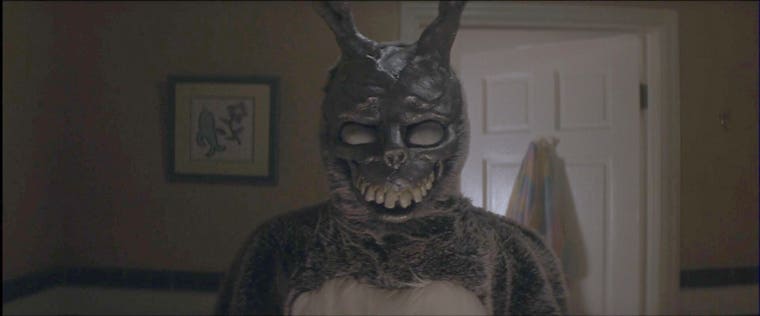
I scared myself embedding this image into the web page.
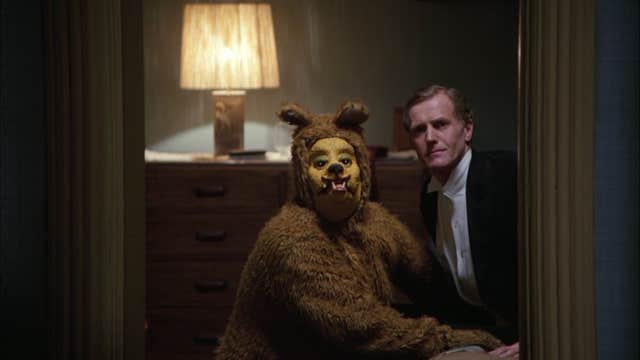
If you’re going to steal, steal from the best.
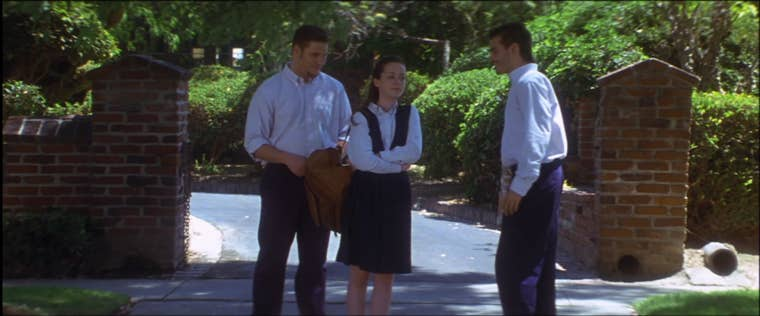
Gretchen is first attracted to Donnie because he represents safety when she is threatened by Ricky and Seth. It’s good that she escaped their harassment, but this is not the foundation for a strong, loving relationship.
Chapter 8 - What is the Timeline of events (For Real)?
We built a detailed timeline that took into account the logic of time travel, but now that we understand the symbolism of Donnie Darko, we can ignore all the science-fiction and fantasy and understand Donnie Darko as a movie about a true story.
1: Richard Kelly is eleven years old. The “David” character is the mask this personality wears. Kelly fantasizes about being a violent and transgressive teenager.
2: This fantasy casts Kelly as “Donnie Darko” just as a nerdy kid might have a separate superhero persona. Initially, this story is as optimistic as a superhero story with Donnie fighting the bad guys, but it ends with Donnie arrested and dozens dead including his mother and younger sister. The bizarre circumstances of his mother’s death can now be understood. An immature mind was imagining a bad outcome and “mother dying” was the go-to. The overly complicated sci-fi story of the mother being on the plane is merely an outgrowth of this instinct.
3: 11-year-old Richard Kelly rejects this fantasy and “kills” Donnie Darko.
4: Back in the present, the retroactive death of Donnie takes the form of a jet engine from the future “smoosh[ing]” Donnie.
5: Richard Kelly at age 16 lives a quiet life of despair as a meek, obedient teenager.
6: At age 21, Kelly is an art school rebel. This persona wears the mask of “Frank.” However, Frank also needs to be obscured in this bananas story, so he wears a literal mask.
7: At age 24, Kelly regrets being a meek, obedient teenager and re-considers his decision to not become a dark teenager. This means recalling his earlier fantasy.
8: In order for Donnie to live, “God” acting through “Frank,” gets Donnie to exit the house before the jet engine hits. This represents Kelly re-imagining his fantasy life. However, he immediately regrets it. Steps 8A-8L are the clumsy moments of “Divine Intervention.” This is Kelly getting his fantasy to perfectly align with the original Donnie Darko fantasy, otherwise Kelly will have to accept that he made bad decision and the regret would be unbearable. Arranging for his mother (and not Mrs. Farmer) to die might seem like a pointless move, but that’s the “story” and he’s sticking to it.
9: After a second loop through time, the jet engine kills Donnie Darko and Kelly remembers the life he led in reality (the Primary Universe) and not a fantasy (the Tangent Universe), therefore, Kelly has avoided a psychotic break with reality.
10: Kelly is 24, but this time, he has the wisdom he did not have when he was 11, 16 or 21. He turns this knowledge into the screenplay Donnie Darko.
I could have gotten some of the details wrong, but there is no other way to make this story make sense. We have a combination of detailed events from Kelly’s life, things he wished had happened, things that he used to wish would happen, fantasy, and it’s all jumbled up chronologically. This describes memories as we experience them. This is a real depiction of the unreal.
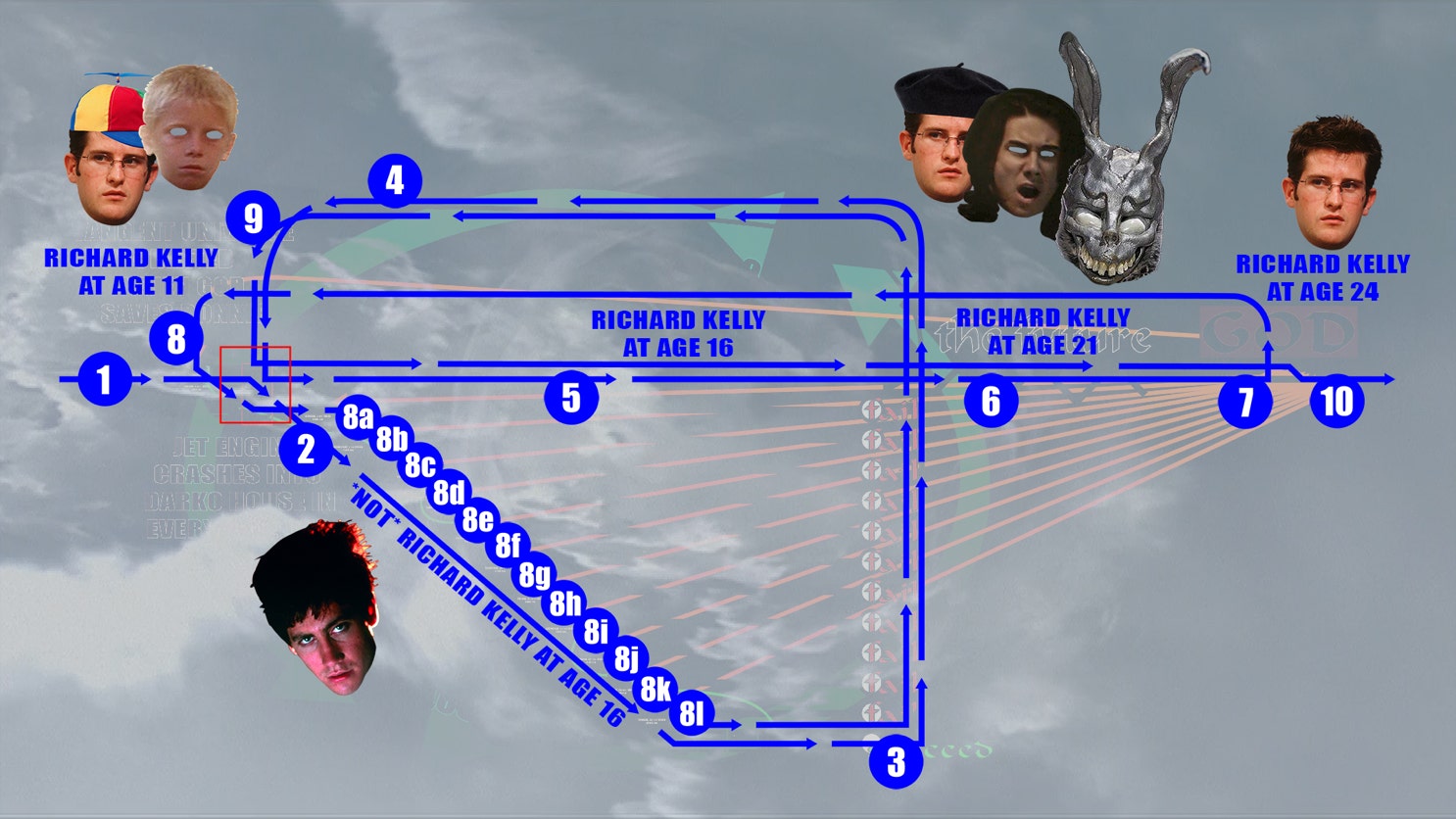
Chapter 9 - What’s up with ‘Sparkle Motion,’ and why is Drew Barrymore in this movie?
The most prominent theme of Donnie Darko is the young being hurt by their elders. Jim Cunningham is a child rapist. The school indoctrinates rather than educates. No one protects the bullied from the bullies. Donnie is transgressive against this culture.
There is another example of exploitation that is kind of lost in the shuffle. The dance troupe “Sparkle Motion” is supposed to be the victims of exploitation.
Ms. Farmer: Now girls . . . I want you to concentrate. Failure is not an option. And Bethany . . . if you feel the need to vomit up there. Just swallow it.
Beth: OK, Mom.
They make the trip to Los Angeles to be on “Star Search.” This is supposed to be tragic for the girls—literally young girls entertaining grown men with dance moves.
If you think that I’ve been too fawning over Richard Kelly, I am happy to point out his failures. Sparkle Motion doesn’t come off as victims of exploitation because they’re just too cute. Even the most jaded Donnie Darko fan is singing along with Duran Duran’s “Notorious.” When we first see them in the famous Monday morning montage, they seem cool, not victimized. Oops.
I bring this up to point out that Drew Barrymore’s casting is a bit of meta-casting. Barrymore was terribly exploited as a child actor, and it’s actually quite inspiring that she’s moved beyond it to do some good work. Her character, Ms. Pomeroy, is disgusted by Sparkle Motion. Ms. Pomeroy gets it. At the talent show, everyone is laughing and smiling except for Ms. Pomeroy.
Drew Barrymore’s early involvement with the film is the reason it got made.10 She has an executive producer credit. This is usually a vanity credit, but I think that Barrymore earned it. She was obviously attracted to the themes of exploitation and, as one of the good teachers, her character is heroic.
But the film seems to have done a 180 and presented Sparkle Motion unironically. Why? I don’t know, but I can forgive Richard Kelly if he lost control of five young actresses who wanted to play adorable kids. One of the actresses is named “Jazzie” for crying out loud.
The reason I bring it up is to put the flight to Los Angeles into context. This wasn’t a fun trip that ended in tragedy, it was always supposed to be tragic. The girls were being sent by one groomer to a city of groomers.
Remember, they came back to Virginia, but they were supposed to go right back to L.A. to compete again, and likely pursue a career in show business and end up abused and addicted like Drew Barrymore.
However, the plane is destroyed by God, like a Sodom in the sky. Is Kelly saying that Rose, Samantha or anyone deserved punishment? No, but bad things happen when people do bad things.
In the Primary Universe, reality, they go to Hollywood with Ms. Farmer instead of Rose Darko. How does that affect the outcome? Would Ms. Farmer make their situation even worse? Would Samantha go to L.A. if she’s still mourning her brother? We don’t know, but, whether Donnie lives or dies, the exploitation will continue.
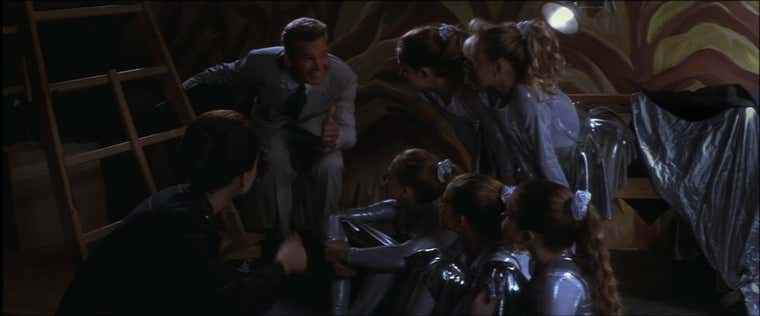
A pedophile fawning over what are supposed to be young children entertaining adults in a socially acceptable manner is a perfect image from Donnie Darko.
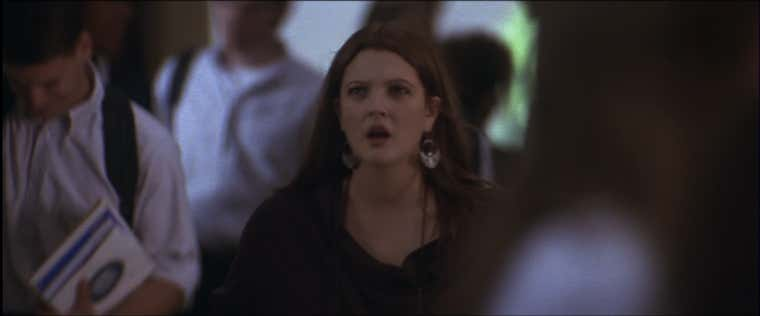
Ms. Pomeroy is outraged to learn that the girls are being sent to Los Angeles, perhaps to have the same experiences that Drew Barrymore had.
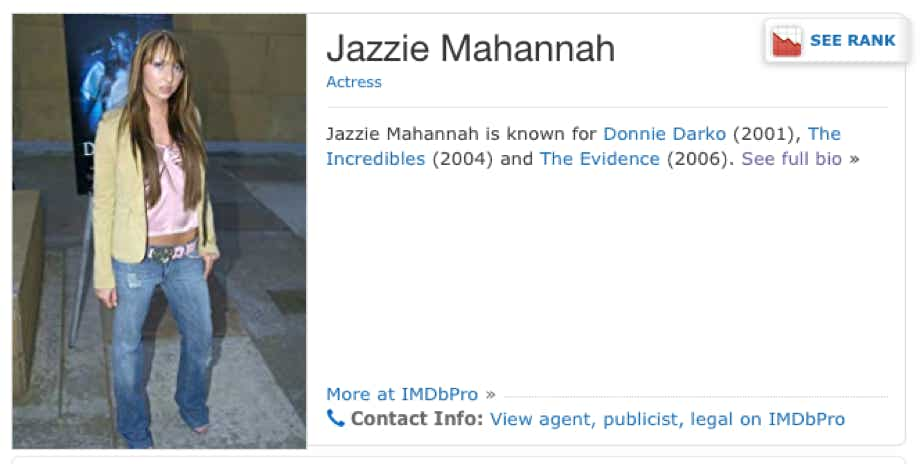
“Jazzie, you’re playing a tragic, ironic figure.”
“I’d rather play Joanie as a fun kid who loves to dance.”
“Fuck. Alright.”
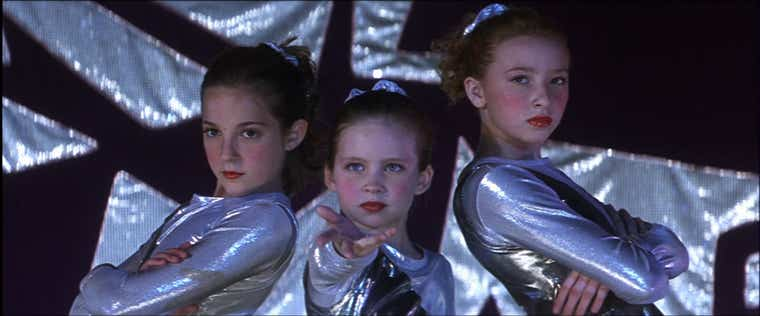
You can just barely see Samantha become a tragic figure. This confident pose was supposed to be ironic, but who couldn’t love Sparkle Motion?
Conclusion
Donnie Darko is about how Generation X is screwed up because society tried to fit us into one of two roles, neither of which is ideal, and so we have a lot of angst and things are generally dysfunctional. You probably got that the first time you saw the movie. You didn’t need this or any other explanation to know that, you understood it instinctively. That’s a truly remarkable cinematic feat.
Did Gen Xers have to choose between being a meek conformist or a violent criminal? No, but we were conditioned that way and children can’t transcend their parenting until they mature. Donnie had to choose to become a monster or to not exist. He was incapable of any other choice.
Did Richard Kelly escape this fate? I think that he thinks he did. Making a film—art—that connects with a screwed-up generation, something constructive, something assertive but not violent, critical but not angry, polite but firm, subversive but not criminal, this is the third way for Kelly. He has escaped fate as his creations did not.
Perhaps Kelly thought that the authoritarian society he grew up in was going away. Ironically, Donnie Darko was set for release when the terrorist attacks of 11 September 2001 happened and things got much worse very quickly. Coincidentally, this is why the movie failed at the box office. Who wants to see a dark film involving a plane crash in October 2001? The fact that it eventually found an audience is testimony to its resonance with Generation X.
What will the next generation be like? I don’t know, but with the real-life Jim Cunninghams and Kitty Farmers getting stronger and more emboldened, maybe we need a real-life Donnie Darko.
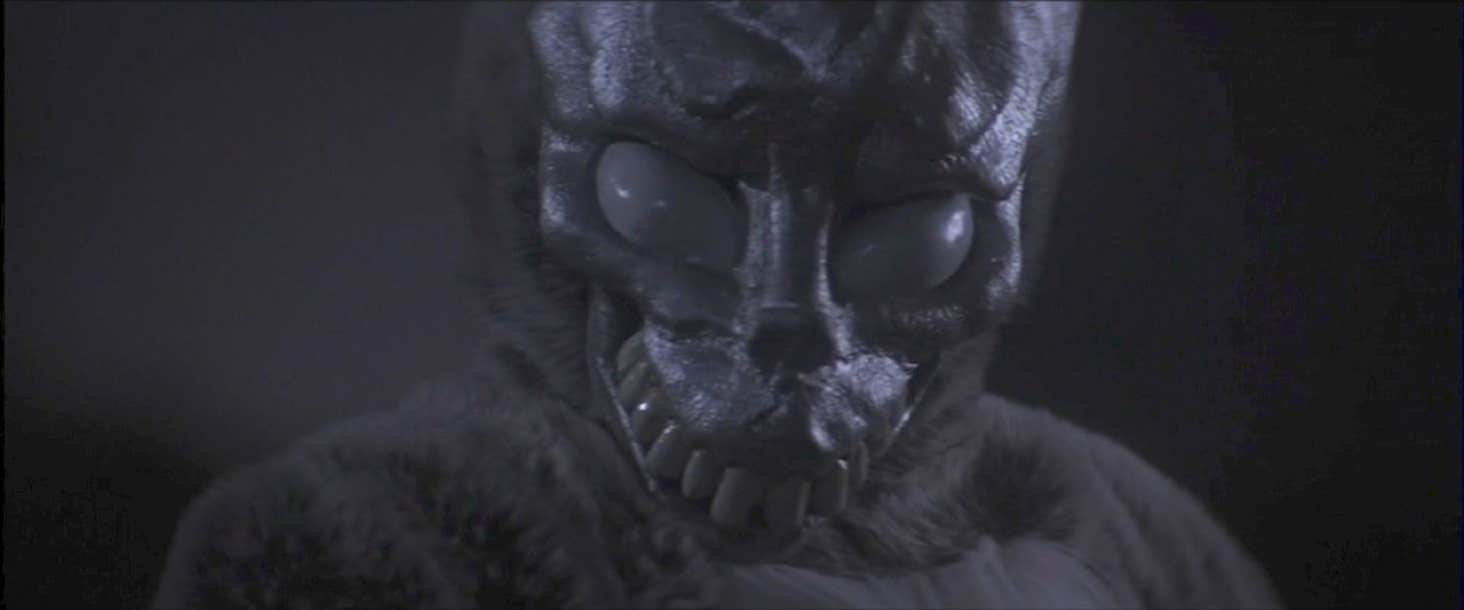
“Burn it to the ground.”
1 Twin Peaks ACTUALLY EXPLAINED (No, Really) 00:06:18
2 Donnie Darko: Director’s Cut Blu-ray disc, director’s commentary.
7 Berriman, Ian. Donnie Darko at 20: How director Richard Kelly made the cult classic. GamesRadar. 26 October 2021.
8 Slate, Jeff. Donnie Darko, a perfect reminder of the weirdness of Reagan’s America, returns. Quartz. 30 March 2017.
9 Donnie Darko: Theatrical Cut Blu-ray disc, director’s commentary.


